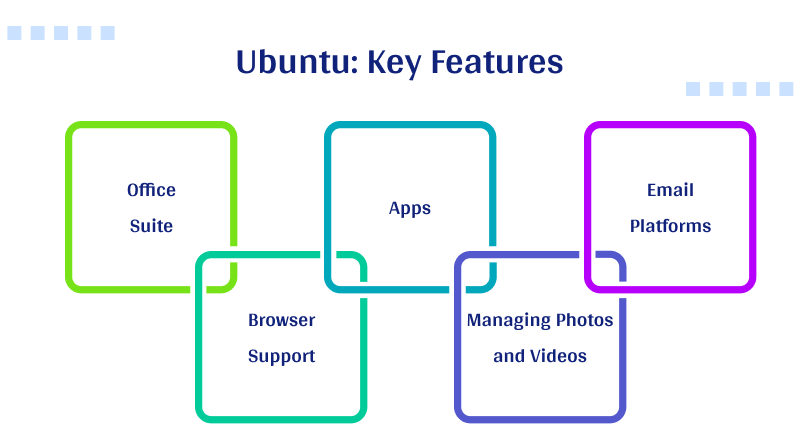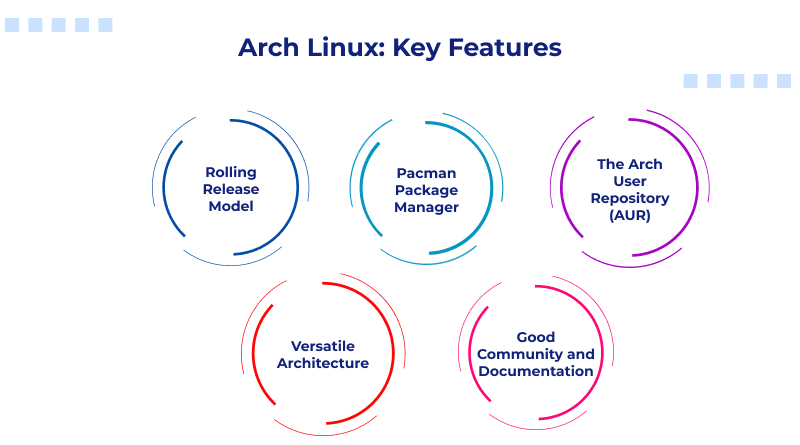Linux is a popular operating system used in the web hosting industry. This guide discusses in-depth comparisons of two of the best Linux distros, Arch Linux and Ubuntu. As we all know, Ubuntu and Arch Linux are open source and free, but each of them has strengths and weaknesses.
Both Linux distros may have similarities in usage, but there are some key differences that cannot be ignored. These unheard differences will impact your operations and lead to a cascading effect on your Linux-based projects.
Table Of Content
What is Ubuntu?
Ubuntu is an open-source Linux operating system released in 2004. It was released by South African entrepreneur Mark Shuttleworth. Ubuntu is a suitable operating system for home or small businesses. It is accessible on PCs and servers. Thus, we offer Ubuntu VPS for Linux clients.
Ubuntu is a perfect replacement for Windows. So, any application that is inaccessible on Windows OS can be functional on Ubuntu. This Linux distro supports global language with international standard security.
Ubuntu: Key Features

1. Office Suite
Ubuntu offers LibreOffice, which is similar to the MS Office suite. It solves the end-user’s need for creating PowerPoint and spreadsheets similar to MS Office and allows sharing documents with others. In addition, in Ubuntu, Google documents are also executed and opened.
2. Apps
Popular apps like Spotify, Skype, Slack, and Telegram are available on Ubuntu. Its app library is called Ubuntu Software. And if you are dissatisfied with the searched apps, you have an option to find an alternative as well.
3. Email Platforms
Ubuntu supports a number of email platforms, including Thunderbird, Gmail, Microsoft Exchange, and Hotmail.
4. Browser Support
In addition to providing security and superior speed, Ubuntu supports the most popular web browsers, such as Chrome. Additionally, Ubuntu Software, which is Ubuntu’s app store, provides easy access to popular browsers.
5. Managing Photos and Videos
On Ubuntu, applications like Gimp, Shotwell, and Krita are accessible. With these applications, users can organize, manage, share, view, or edit photos/videos. Video player software like OpenShot or VLC is also accessible on Ubuntu.
Advantages of Ubuntu
Ubuntu, as one of the most popular Linux distributions, offers you many advantages, including:
1. Active Community Support
Ubuntu has active community support from developers and programmers. If there is any problem using Ubuntu or if any bugs arise in this OS, the programmer community or our support team is available to assist you. Compared to other Linux distros, Ubuntu has the most active community support.
2. Free with No Push Notifications
Ubuntu can be downloaded and installed with one click from the Canonical website whenever you want to use it. Advertisements are not intrusive. To take advantage of its features, you won’t have to watch a few seconds of commercial videos. As a result, Ubuntu’s appealing graphical user interface is less cluttered.
3. A Vibrant Desktop Alternative
It has been known that Linux is the command line for many years. It is designed exclusively for Linux servers. In contrast to many other Linux distributions, Ubuntu Linux has an attractive and user-friendly graphical user interface similar to Windows.
4. Efficiency and Speed in Ubuntu
The Ubuntu desktop version does not have the incomprehensible and vague Linux environment. Ubuntu’s friendly and simple environment will welcome you regardless of your Linux experience. Because Ubuntu has a simple environment, you can easily manage files and remove or install programs. Additionally, resource management allows you to run multiple apps simultaneously without experiencing any system slowdown.
What is Arch Linux?
Arch Linux was an early arrival compared to Ubuntu. It was launched in 2002 by a Canadian scientist, Judd Vinet. Whereas most Linux distributions are easier to use, Arch Linux seems a bit confusing for beginners because the main criterion of its development provides an environment for customization. It functions on a DIY (Do-It-Yourself) philosophy where users provide a minimal base system that users build. A key feature is its rolling release model, which means it is constantly updated with the latest software versions, unlike distributions that release major updates every few months or years.
Arch Linux: Key Features

1. Rolling Release Model
Arch Linux follows a rolling release concept, which means that users are provided with the latest updates in an endless manner; thus, it does not need to reinstall the operating system. Instead of having to upgrade versions periodically, users are granted unlimited access to the most recent kernel, drivers, and software, and they are left with a modernized and stable system through regular maintenance.
2. Pacman Package Manager
The heart of Arch Linux is the lightweight but effective package manager Pacman, which is designed to be simple and fast. It will automatically install, update, and uninstall software and cleverly manage dependencies, making system administration not only smooth but also, to developers, approachable.
3. The Arch User Repository (AUR)
The Arch User Repository (AUR) is one of the most important assets of Arch Linux and is an open-source, community-driven repository of thousands of user-contributed packages. It allows users the flexibility and freedom to easily install niche or newly created applications not found in the official repositories, thus promoting flexibility and open interaction within the Arch community.
4. Versatile Architecture
Arch Linux gives the user full access to every component of the system. It can be started with a simple base and built up with the environment, taking only packages, desktop environment, and utilities that are considered necessary. Through this method, a clean and lightweight, purpose-designed, and performance-optimized operating system is produced.
5. Good Community and Documentation
The Arch Wiki has been recognized as one of the most encompassing Linux documentation sources on the Web. Authorized by a blogging user’s community, it helps both beginners and professionals troubleshoot, learn, and master their systems, thus supporting the Do It Yourself philosophy of Arch Linux through collective knowledge and assistance.
Advantages of Arch Linux
1. Complete Control and Customization
Arch Linux is for power users or anyone who wants complete control of their operating system. You choose your desktop environment, and you only install the applications that you deem necessary to be productive—which leads to a very light, fast, and clean operating system.
2. Updated All Times
The rolling release system of Arch Linux ensures that you can always run the latest version of your software and kernel. There is no need to wait for a major version of the OS; you will continuously receive updates, which means that you will always be up-to-date, secure, and compatible with emerging technologies.
3. Vast Software Available via AUR
The Arch User Repository (AUR) provides access to thousands of user-maintained software packages, outside of the official repository. Whether it be for an obscure piece of software or the latest development tools, it saves you time with its user-friendly installation process while fostering public innovation and collaboration.
4. Documentation and Community
The Arch Wiki and forums are amongst the best resources in the entire Linux ecosystem. There is a manual for every configuration, every error fix, or tinker you want to do, even for a user that has just started. Plus, the system is so well supported by the community that you will always be able to find help, no matter how complex.
Ubuntu vs Arch Linux: Key Differences
| Feature | Ubuntu | Arch Linux |
| Target User | Beginners, casual users, businesses, stability seekers | Power users, developers, Linux enthusiasts, those seeking full control |
| Installation | Easy, Graphical Installer (GUI) | Complex, Command-Line Interface (CLI) based, manual configuration |
| Release Model | Fixed Releases (e.g., every 6 months, LTS every 2 years) | Rolling Release (continuous updates, always “bleeding-edge”) |
| Package Manager | APT (Advanced Package Tool), using .deb packages | Pacman (Package Manager), using .pkg.tar.zst packages |
| Software Availability | Official repositories, PPAs (Personal Package Archives) | Official repositories, AUR (Arch User Repository) for community packages |
| Customization | Moderate; comes with a pre-configured GNOME desktop | High/Total; users build the system from a minimal base |
| Default Experience | User-friendly, pre-installed software (often considered “bloated”) | Minimalist, “Do It Yourself” (DIY) approach |
| Stability | Focus on stability and thorough testing before releases | Potential for instability due to continuous, fast-paced updates |
| Base Distribution | Derived from Debian | Independent, built from scratch |
Ubuntu vs Arch Linux: Key Releases
| Feature | Ubuntu (Fixed/Point Release) | Arch Linux (Rolling Release) |
| Release Model | Fixed Release with Long Term Support (LTS) | Rolling Release |
| Release Cadence | New major release every 6 months (April and October). LTS releases every 2 years (in April). | No fixed release schedule. Updates are continuous and pushed to repositories as soon as they are tested. |
| Version Naming | YY.MM format (e.g., 24.04, 24.10) with an animal Codename (e.g., Noble Numbat). | No version numbers for the entire distribution. The installation media (ISO) is generally dated YYYY.MM.DD but is simply a snapshot of the current state of the rolling system. |
| Package Versions | Packages are fixed at the time of the major release; critical and security updates are backported. Older software versions are common in non-LTS releases. | Packages are almost always the latest stable version available from upstream developers (“bleeding edge”). |
| Major Releases | LTS Releases are the most significant. | Installation ISO Snapshots are the only “releases” and primarily serve as a convenient starting point for new installations. |
| Support Lifetime | LTS: 5 years of standard support (up to 10 years with Ubuntu Pro/ESM). Non-LTS: 9 months of support. | Infinite, as long as the user continuously updates their system. There is no End-of-Life (EOL) for the distribution itself. |
Arch Linux and Ubuntu are two major Linux distros with different functionalities. The choice between the two will depend on what users’ needs, as well as the technical skills of the users. If you are looking for a system that is more focused around stability, ease of use and being ready to go, then Ubuntu is the type of system you would want to use. Ubuntu has a more polished experience for the beginner, the business user, or just anyone who wants to do a little less maintenance to their system.
Arch Linux appears to be the clear choice for the power user or the enthusiast who demands full control over their system, wants to do a streamlined install and use the latest and greatest software, and does not mind spending time tailoring and maintaining a high degree of customization.
FAQs
1. What is the downside of Arch Linux?
Arch Linux requires manual setup and maintenance, which can be challenging for beginners.
2. Why is Arch Linux better than Ubuntu?
Arch offers more control, customization, and up-to-date software through its rolling release model.
3. Is Arch Linux ok for beginners?
Not really; it’s better suited for experienced users comfortable with command-line management.
4. Is Arch the fastest Linux?
Yes, Arch is known for its lightweight and optimized performance, making it one of the fastest Linux distributions.








